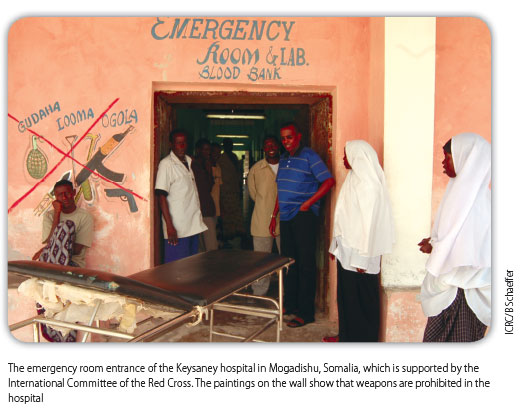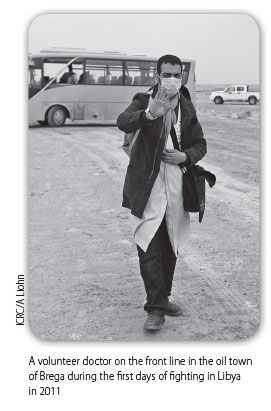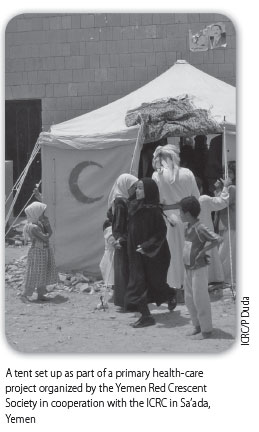NEWS
Keeping health workers and facilities safe in war
The nature of armed conflict is changing, putting health workers increasingly in harm's way. A new campaign aims to raise awareness and improve conditions on the ground for health workers and facilities in conflict zones. Jack Serle and Fiona Fleck report.
Robin Coupland knows what it's like to get caught up in conflicts. In Somalia, in the early 1990s, the former war surgeon was in the operating theatre when a colleague standing next to him was shot. "There were no sandbags so we had to pile boxes of intravenous fluids against the windows," he recalls.
For the past two decades Coupland, a medical adviser with the International Committee of the Red Cross (ICRC), has been working to reduce the likelihood of such incidents occurring through a mixture of advocacy and research, and most recently by co-authoring an ICRC study titled Health Care in Danger, a first attempt to describe how and why health workers get caught in the cross fire, and what the consequences are when they do. The study was released in August last year at the start of a four-year ICRC campaign to raise awareness around the problem and make a difference to health workers on the ground.
The harm done when health workers are attacked is not limited to the assault itself, but has a knock on effect that can deprive patients of treatment. This is one of the core messages of the study, which cites the example of the six ICRC health workers killed in the Chechen village of Novye Atagi (in the Russian Federation) on 17 December 1996, prompting the organization to suspend its operations in Chechnya. According to the study, this single incident deprived thousands of war-wounded of surgical care.
But is health care, or are health workers, in more danger now than, say, 63 years ago when the Geneva Conventions were first drawn up? Susannah Sirkin, deputy director of Physicians for Human Rights, believes this is so. The independent research and advocacy group has been gathering information about attacks on health workers and health institutions for years. "The intensity of attacks, especially in terms of doctors being threatened, has increased," Sirkin says. But in the absence of reliable data on this phenomenon, Physicians for Human Rights, like the ICRC, can only make intelligent guesses about what is really going on.

Coupland's guesses are based on two interesting observations. The first is the way in which war itself is changing. "The wounded and the hospitals are becoming integrated into the conflict", he says, as wars are increasingly fought within rather than between countries with clearly defined fronts, where combatants are not always aware of these international conventions governing the way civilians should be treated.
Because of the blurred nature of contemporary war, health facilities find themselves providing services to both sides of a conflict and exposing themselves in doing so. As Coupland points out, it is more common today for soldiers to enter a hospital to settle scores, for example, or indeed for government forces to come looking for insurgents and - as seen during last year's protests and uprisings in the Middle East - prevent doctors from treating opponents.
Coupland's second observation is the ubiquity of cameras and journalists. "What happens at a hospital is a focal point for the media," he says. In his opinion this makes health care not just an integral part of a conflict but also essential to the way the conflict is viewed by the outside world. Once again, media attention tends to bring people into the hospital who do not belong there.
That's why people with experience in the field go to great lengths to avert such interference and intervention when they open the hospital doors. Andrew Cunningham, Operations Adviser with nongovernmental organization (NGO) Médecins Sans Frontières (MSF), for example, says that negotiating what he calls the "parameters of intervention" before starting operations is essential. "For Afghanistan we spent about nine months communicating and negotiating with all the relevant military and paramilitary actors to create the neutral space in which we could work before starting the programme there," he says.
This kind of pre-intervention negotiation is also a key part of the approach proposed by the ICRC as part of its Health Care in Danger strategy, which stresses the importance of creating safe conditions on the ground, including the pre-negotiation of safe zones for health workers. Of course laying down ground rules and enforcing them are two different things and here too MSF's Cunningham is unequivocal, adding that they are very "vocal and firm" about any incidents. Smaller organizations are likely to be more vulnerable.
Establishing safe conditions on the ground is made much easier if there is agreement at the very top end of government, and the ICRC encourages people to make full use of diplomatic channels when preparing the terrain for humanitarian intervention. According to Coupland, there is no need to draw up a new treaty or to draft new laws, pointing out that the laws already exist - they just need to be applied.
"It's not only governments that are bound by the Geneva Conventions, but armed groups are too. The moment an armed group takes up an armed struggle as an organized body, then it has obligations under humanitarian law," Coupland says.
Coupland is pleased that an increasing number of health-orientated NGOs are becoming involved in the campaign. He is also encouraged by the fact that the issue was raised at the World Health Assembly in May last year, and that World Health Organization (WHO) Director-General, Dr Margaret Chan, in her opening speech, called on "all parties to ensure the protection of health workers and health facilities in conflict situations, to enable them to provide care for the sick and injured".

Also addressing the World Health Assembly last May, Mary Wakefield, director of the Health Resources and Services Administration of the United States of America, drew attention to the disruption to health systems resulting from violence against health workers in conflict and post-conflict situations. She said it was necessary to do "research to generate data and build a sound evidence base, including best practices" to tackle the problem.
Coupland and others believe that WHO has an important role to play in data gathering on insecurity affecting health care. "Look at what WHO is doing in terms of gathering information pertinent to infectious diseases. Where is the equivalent for violent incidents affecting health-care workers and facilities?" he asks.
For the moment there is no equivalent system for gathering these data and the lack of a solid evidence base is frustrating for those who want change. Tesfamicael Ghebrehiwet, consultant on nursing and health policy at the International Council of Nurses, underscores the difficulties. For example, he says he must rely on Amnesty International and other sources to find out how many health professionals have been arrested in a given incident because sometimes members are too afraid to come forward, despite having "an ethical mandate" to speak up about abuses. Not that he blames them. "Who would blow the whistle if they knew that their life was on the line? Would you speak up?" he asks. "I wouldn't."
"Even with a limited base of information you can talk of trends", says Bruce Aylward, assistant director general of the Polio, Emergencies and Country Collaboration cluster of departments at WHO. Part of the newly formed cluster's work will be developing methods and gathering data on violence against health workers and health facilities.

Aylward believes that WHO can make an important contribution by bringing together adversarial groups to remind them of their legal obligations, as demonstrated by its recent intervention in Yemen, where the WHO Representative to the country Ghulam Popal pushed for "the continuous delivery of health services to all [the] affected population without discrimination". After extensive negotiations, a meeting was held last April at the WHO Country Office in the capital Sana'a attended by the ministry of health and opposition representatives. At the end of the meeting, a memorandum of understanding was signed by both sides on the provision of "impartial and neutral health services" to all those in need.
WHO is helping to monitor the implementation of the agreement and resolve any disputes. It trained 30 master trainers in mass casualty management, who went on to train a further 200 medical staff. Advanced medical posts and field hospitals were set up in the demonstration areas staffed by medical workers from the opposition, known as the "youth volunteers," with support from WHO. 
